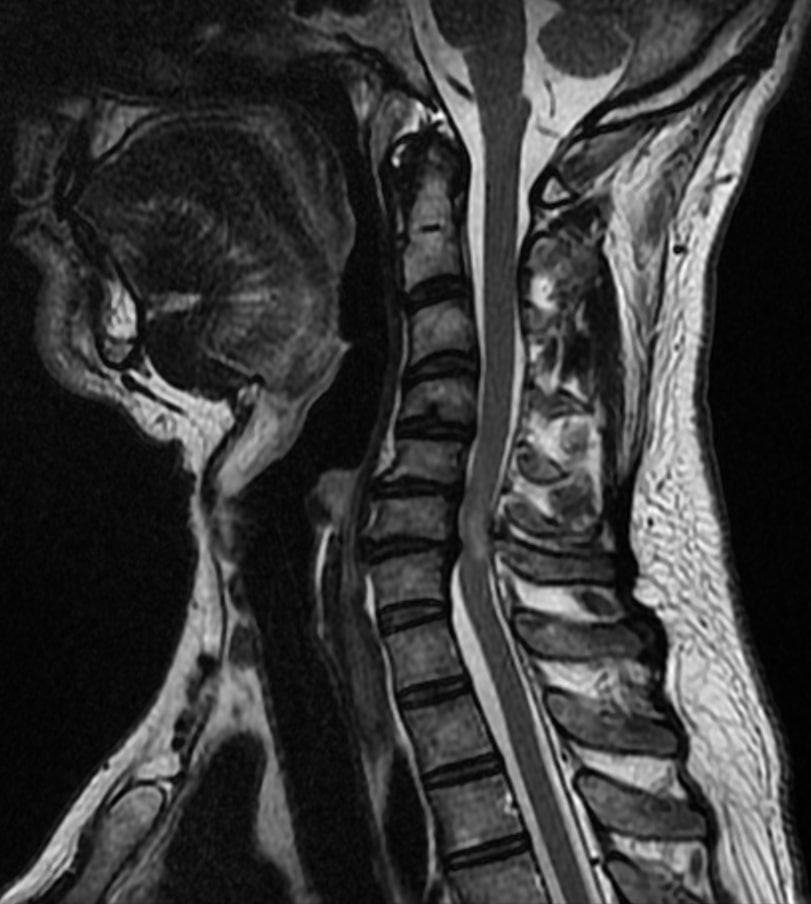Cervical Myelopathy

| |
| Cervical Myelopathy | |
|---|---|
| Clinical Features | lower motor neuron findings the level of the lesion and upper motor neuron findings below the level of the lesion |
Myelopathy is term that describes a spinal cord lesion that is confined to a discrete level, for example from trauma, tumour, or central disc protrusion. Symptoms and signs of myelopathy occur in the upper limbs, trunk, and lower limbs. The examination is used to determine whether long tract signs are present such as hyperreflexia, spasticity, and a positive Hoffman's sign. Patients may present with signs only in the upper limbs. There is the absence of lower motor neurone signs
Aetiology
- Degenerative spondylosis
- Trauma (bone lesion, central disc herniation, epidural haemorrhage)
- Tumour (extradural or indradural)
- Infection (abscess)
- Haematoma
- Rheumatoid Arthritis
- Fluorosis
- Onchronotic vertebral arthropathy
- Vascular: Craniocervical junction dural AV fistula
- Syringomyelia
Also consider non-compressive myelopathy.
Clinical Features
The lesion causes motor, sensory, and reflex abnormalities at the level of the lesion and below it.
Gait: May be disturbed with sensory ataxia due to a combination of proprioceptive defects, hypertonicity, and weakness.
Weakness: The weakness is of the lower motor neuron type at the level of the lesion (from damage to anterior horn cells and spinal roots), and of the upper motor neuron type below the level of the lesion (from damage to the descending upper motor neuron paths). An exception is that lesions at the foramen magnum and C3 to C4 can sometimes produce atrophy in the hands.
One needs to be familiar with the spinal innervation of the muscles. For example, in someone with a C7 segment spinal cord lesion, there is lower motor neuron weakness in the C7 muscles, but upper motor neuron weakness of the muscles below this level (e.g. in the lower limbs). The muscles from the segments above C7 are normal.
The myelopathic hand has difficulty with adduction and extension of the ulnar fingers. There may also be impairment of smooth movement during grip and release called the grip-and-release sign.
Sensation: There may be deep sensation defects in severe disease involving proprioception and vibration sense, due to posterior column compression.
Reflexes: There may be a hyperactive pectoralis reflex for lesions above C4.[1]
Bowel and Bladder Features: Urinary incontinence can occur in long standing disease. Otherwise bowel and bladder dysfunction are uncommon.
Pain: Neck pain may be a feature but is not normally prominent, and does not tend to occur early unlike cervical radiculopathy.
Special Tests
- Lhermittes sign (electric shock down torso on neck flexion)
- Foot tapping test
- Hand clenching test
- With back against the wall, unable to extend head back to touch the wall.
- Hoffman test, facilitated by cervical extension
- Inverted supinator jerk
- Clonus
- Finger escape sign
- Gait loading test: Spinal claudication may occur with tightness, weakness, and numbness in the lower limbs and a strangulated sensation in the trunk to lower limbs along with occurrence and/or aggravation of spinothalamic signs.[2]
Diagnosis
The following cluster of clinical features can be used to guide diagnostic reasoning.[3]
- Gait deviations
- Positive Hoffman’s
- Inverted supinator sign
- Positive Babinski
- Age >45 years
When 3/5 positive, then cervical myelopathy can be ruled in (+LR 30.9). When 1/5 positive, CSM could be ruled out (-LR 0.18)
Hoffman’s, Babinski, clonus and hyperreflexia are commonly used to rule out myelopathy. These tests by themselves demonstrate low sensitivity and are not appropriate for ruling out myelopathy
Imaging
MRI is best. Severe cord atrophy and high signal suggests a poor prognosis. The findings are pancake-like intramedullary gadolinium enhancement caused by focal blood-brain barrier disruption.
Differential Diagnosis
- Amyotrophic lateral sclerosis
- Multifocal motor neuropathy
- Multiple sclerosis
- Syringomyelia
- Peripheral neuropathy
Treatment
Conservative in mildly affected people, otherwise surgical management.
Indications for surgical treatment are progression of signs and symptoms, myelopathy for over 6 months, persistent radiculopathy that is unresponsive to physiotherpay and immobilisation, compression ratio approaching 0.4, severe pain and dysfunction, and rapid deterioration. There are a variety of surgical techniques.
See Also
References
- ↑ Paholpak, Permsak; Jirarattanaphochai, Kitti; Sae-Jung, Surachai; Wittayapairoj, Kriangkrai (2013-12). "Clinical correlation of cervical myelopathy and the hyperactive pectoralis reflex". Journal of Spinal Disorders & Techniques. 26 (8): E314–318. doi:10.1097/BSD.0b013e3182886edb. ISSN 1539-2465. PMID 23429310. Check date values in:
|date=(help) - ↑ Kikuchi, S.; Watanabe, E.; Hasue, M. (1996-02-01). "Spinal intermittent claudication due to cervical and thoracic degenerative spine disease". Spine. 21 (3): 313–318. doi:10.1097/00007632-199602010-00011. ISSN 0362-2436. PMID 8742206.
- ↑ Cook, Chad; Brown, Christopher; Isaacs, Robert; Roman, Matthew; Davis, Samuel; Richardson, William (2010-12). "Clustered clinical findings for diagnosis of cervical spine myelopathy". The Journal of Manual & Manipulative Therapy. 18 (4): 175–180. doi:10.1179/106698110X12804993427045. ISSN 2042-6186. PMC 3113267. PMID 22131790. Check date values in:
|date=(help)
Literature Review
- Reviews from the last 7 years: review articles, free review articles, systematic reviews, meta-analyses, NCBI Bookshelf
- Articles from all years: PubMed search, Google Scholar search.
- TRIP Database: clinical publications about evidence-based medicine.
- Other Wikis: Radiopaedia, Wikipedia Search, Wikipedia I Feel Lucky, Orthobullets,


